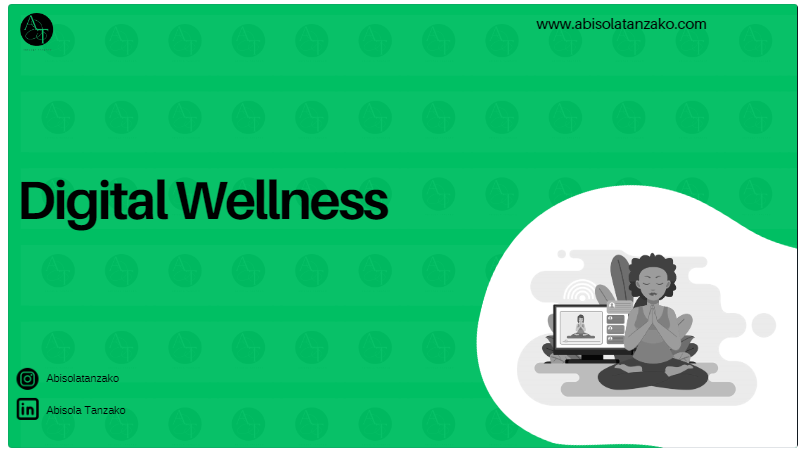In our contemporary society, computers, smartphones, and various digital devices have become essential in our daily routines. These technological tools play a significant role in assisting us with various tasks and activities. However, it’s necessary to recognize that, despite the convenience of digital devices, there is a need for digital wellness; there are times when these devices can negatively affect our well-being.
For instance, spending extended periods on computers or smartphones can lead to physical fatigue, eye strain, and mental exhaustion. Moreover, these devices’ constant connectivity and information overload can sometimes overwhelm and stress us.
To address these challenges and ensure a reasonable coexistence with our digital companions, it’s essential to balance utilizing these devices to accomplish tasks efficiently and taking the necessary steps to care for our physical and mental health.
What is digital wellness?

Digital wellness means maintaining a healthy relationship with technology and digital devices. That means being responsible with our digital devices and using them in a way that does not hurt others or ourselves.
Lisa Pendor, a digital wellness educator, says that digital wellness is the optimal state of health and well-being that one can achieve while using technology. It is also about empowering oneself to use technology while avoiding its associated harm.
Digital wellness is practicing and putting healthy digital habits in place.
Ways to balance productivity and well-being in the digital age
Set boundaries on screen time
Setting boundaries on screen time is a vital strategy for achieving a balance between productivity and well-being in the digital age. This approach involves allocating specific time slots for digital devices, whether for work or leisure and imposing daily or weekly limits to prevent excessive screen usage. By doing so, individuals can manage their digital engagement more effectively, reducing the risk of burnout and fatigue while ensuring that their time spent on screens is purposeful and mindful, ultimately contributing to enhanced productivity and overall well-being.
Take regular breaks

As seen now, where we often spend extended periods working on computers or using smartphones, taking regular breaks is a crucial strategy to maintain a healthy balance between being productive and looking after our well-being. When deeply engrossed in tasks on your computer or phone, it can strain your body and eyes. By pausing and incorporating short breaks into your work routine, you allow your body to reset. During these breaks, you can do simple activities like standing up, stretching your arms and legs, and briefly diverting your gaze away from the screen.
These actions may seem small, but they have a significant impact. They help reduce physical tension, alleviate eye strain, and refresh your mind. When you return to your digital tasks after these short breaks, you’ll likely feel better, more focused, and ready to work more effectively. Taking these breaks is like hitting the reset button for your body and mind in the digital world.
Manage notifications

Managing notifications is a helpful way to balance getting things done and feeling good in the digital age. Notifications are like messages that suddenly appear on your phone or computer, and they can interrupt you while you’re working or doing other things. To avoid these interruptions, you can turn off notifications for apps or messages that aren’t very important.
Instead of reacting to notifications whenever they pop up, you can pick certain times to check your emails or messages, like in the morning and afternoon. This way, you can stay more focused on your tasks and not get distracted by notifications all the time. It helps you use your digital devices more effectively while also reducing stress.
Practice mindfulness
Practicing mindfulness is a simple yet effective way to balance being productive and feeling good in the digital age. Mindfulness means paying close attention to what you’re doing right now. You can do this by taking deep breaths or meditating for a few quiet minutes.
These practices help you feel calmer and more focused on your tasks. It’s essential to stay present and concentrate on the job you’re doing at that moment rather than trying to do many things at once, which can make you feel stressed and less productive. Instead, focus on one thing at a time. This approach helps you do better work and reduces stress, making your digital experience more enjoyable and productive.
Digital detox periods

Taking digital detox periods is a straightforward way to balance being productive and feeling good in our digital world. To do this, you can choose times when you won’t use digital devices, like during meals with your family or before bedtime. These are called “tech-free times.” During these moments, you can take a break from screens, which can help you feel more relaxed and enjoy different activities.
You can use this time to talk to your family, read a book, or pursue a hobby you love, such as drawing or playing a musical instrument. These activities help you unwind and have fun without using digital devices, making your life more enjoyable and well-rounded.
Conclusion
In the digital age, balancing productivity and well-being is crucial. By taking regular breaks, managing emails and notifications, practicing mindfulness, and occasionally doing a digital detox, we can ensure that our digital devices help us work efficiently without causing stress or harming our well-being. Remember, the key to digital wellness is a healthy balance between digital and real life.

